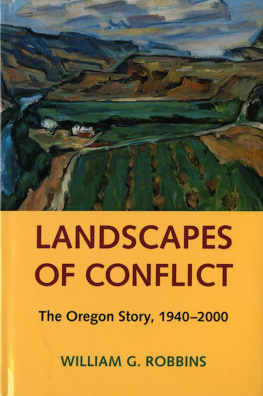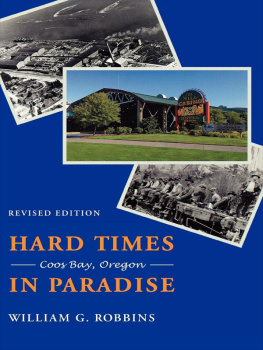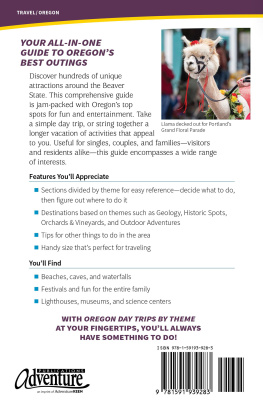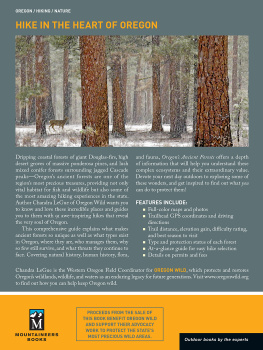LANDSCAPES OF CONFLICT
The Oregon Story, 19402000
LANDSCAPES OF CONFLICT
The Oregon Story, 19402000
WILLIAM G. ROBBINS
Foreword by William Cronon
UNIVERSITY OF WASHINGTON PRESS
Seattle and London
Landscapes of Conflict: The Oregon Story, 19402000 has been published with the assistance of a grant from the Weyerhaeuser Environmental Books Endowment, established by the Weyerhaeuser Company Foundation, members of the Weyerhaeuser family, and Janet and John Creighton.
2004 by the University of Washington Press
Printed in the United States of America
12 11 10 09 08 07 06 05 04 5 4 3 2 1
Designed by Pamela Canell
All rights reserved. No part of this publication may be reproduced or transmitted in any form or by any means, electronic or mechanical, including photocopy, recording, or any information storage or retrieval system, without permission in writing from the publisher.
University of Washington Press, P.O. Box 50096, Seattle, WA 98145
www.washington.edu/uwpress
Library of Congress Cataloging-in-Publication Data
Robbins, William G., 1935
Landscapes of conflict : the Oregon story, 1940-2000/
William G. Robbins ; foreword by William Cronon.
p. cm.(Weyerhaeuser enviromental books)
Includes bibliographical references and index.
ISBN 0-295-98442-2 (acid-free paper)
ISBN 978-0-295-98988-4 (electronic)
1. OregonEnvironmental conditionsHistory.
I. Title. II. Weyerhaeuser enviromental book.
GE155.07R58 2004 333.709795dc22 2004052613
The paper used in this publication is acid-free and recycled from 10 percent post-consumer and at least 50 percent pre-consumer waste. It meets the minimum requirements of American National Standard for Information SciencesPermanence of Paper for Printed Library Materials, ANSI Z39.481984.

Cover image: Painting by Andrew Vincent, The Boegli Ranch (Crooked River at Cove Palisades), c. 1960. Oil on canvas, 25 1/2 33 in. Collection of Michael Parsons.
FOR KARLA
Best friend and companion
through three decades of time
FOREWORD
STILL SEARCHING FOR EDEN AT THE END OF THE OREGON TRAIL
William Cronon
W illiam Robbins' Landscapes of Conflict: The Oregon Story, 19412000 brings to completion the magisterial two-volume survey of Oregon environmental history that he began in 1997 with the publication of Landscapes of Promise: The Oregon Story, 18001940. There are very few books like this one. Although we have a number of fine studies that examine different aspects of environmental change and politics at the state levelArthur McEvoy's pioneering account of legal regulation in the California fisheries, Mark Fiege's richly nuanced interpretation of irrigated agriculture in Idaho, Thomas Huffman's analysis of bipartisan environmental politics in Wisconsin during the 1960s, to name just three distinguished examplesrarely has a senior historian offered a full, broad-gauged synthesis of environmental change and political controversy for an entire state from frontier times to the present.1 Not only will these two volumes instantly become the standard works on Oregon environmental history for the foreseeable future; they should inspire others to see the advantages of state-level geographical scales for understanding the complicated ways that political economy and social change interact with natural environments to produce the landscapes and communities we inhabit today.
Perhaps because so many of the key laws that now govern environmental politics in the United States were passed by Congress in the 1960s and 1970s, it is easy to imagine that the federal government is where the action is if one wants to understand the history of environmentalism in the second half of the twentieth century. Certainly that is the way the subject is most commonly taught in undergraduate courses. Political historians are often drawn to the national scale because it is so much easier to study one body of federal law than it is to grapple with the vast array of separate statutes produced by the fifty states, to say nothing of all the counties and municipalities that lie still further down the federal hierarchy. And certainly one should never downplay the impact of federal laws like the Clean Air and Water Acts, the Wilderness Act, the Endangered Species Act, or the National Environmental Policy Act, not least for their cascading consequences at the state and local levels.
But in fact, many of the most important environmental changes and controversies take place far below the national scale, and even most federal laws find their ultimate expression in enforcement regimes operating at the local level. To take just one obvious example, the laws and funding mechanisms to promote American hydropower in the first half of the twentieth century may have been debated and passed in Washington, D.C., but the impacts of those laws occurred on rivers like the Tennessee, the Colorado, and the Columbia. Moreover, one cannot even begin to comprehend the complexity of those impacts if one limits oneself to the bird's-eye views from Capitol Hill or the White House. Only on the ground can one see the power lines and irrigation ditches and monocultural hybrid crops and pesticides and invasive species and farms and clearcuts and highways and factories and cities and landfills and sewage systemsto say nothing of simple human homesthat together make up the landscapes and political economies and cultures we actually inhabit. As Robbins masterfully demonstrates in this book, the great beauty of a state-based environmental history is that all these phenomena and many more can fit within the single narrative and interpretive frame of a state called Oregon. Although it is true that one cannot understand local history without placing it in its national and global context, it is no less true that one cannot understand national or global history without grounding them in local places where the seemingly abstract effects of much larger systems and processes become real. These systemic environmental interconnections have been William Robbins's scholarly quarry for his entire career, and the care and nuance with which he pursues them in these two volumes make Landscapes of Promise and Conflict his masterpiece.
In Landscapes of Promise, Robbins carried his story down to the eve of the Second World War. His narrative essentially traced a transformation from a colonial settlement frontier to the maturing agro-industrial economy of a settled region. As I wrote in my foreword to that volume, Oregon became in the early nineteenth century an icon for the land of journey's ending, the destination at the far end of an overland trail which despite all its hardships might nonetheless deliver migrating families to a place of milk and honey where it seemed that the mythic promises of Eden might finally be fulfilled. Robbins's own love for the land and people of his adopted statehe first moved to Oregon as a graduate student, and has been there ever sincemean that he fully appreciates the stunning beauty and rich cultural complexity that can so easily make Oregon appear to be a promised land. But perhaps for this very reason, Robbins is equally conscious of the ways in which Eden has also been eroded and betrayed over the long sweep of the state's history. By the end of his first volume, he had demonstrated how the hoped-for landscape of Jeffersonian yeoman farmers that had drawn pioneers to the Oregon Trail in the 1840s had by the early twentieth century become increasingly controlled by large corporations and bureaucratic institutions that threatened environment and community alike.









